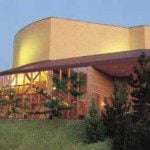
From Richard Grant, “The Whispering of the Trees,” Smithsonian (March 2018):
To communicate through the network, trees send chemical, hormonal and slow-pulsing electrical signals, which scientists are just beginning to decipher. Edward Farmer at the University of Lausanne in Switzerland has been studying the electrical pulses, and he has identified a voltage-based signaling system that appears strikingly similar to animal nervous systems (although he does not suggest that plants have neurons or brains). Alarm and distress appear to be the main topics of tree conversation, although Wohlleben wonders if that’s all they talk about. “What do trees sayswhen there is no danger and they feel content? This I would love to know.” Monica Gagliano at the University of Western Australia has gathered evidence that some plants may also emit and detect sounds, and in particular, a crackling noise in the roots at a frequency of 220 hertz, inaudible to humans.
Trees also communicate through the air, using pheromones and other scent signals. Wohlleben’s favorite example occurs on the hot, dusty savannas of sub-Saharan Africa, where the wide-crowned umbrella thorn acacia is the emblematic tree. When a giraffe starts chewing acacia leaves, the tree notices the injury and emits a distress signal in the form of ethylene gas. Upon detecting this gas, neighboring acacias start pumping tannins into their leaves. In large enough quantities these compounds can sicken or even kill large herbivores.
Giraffes are aware of this, however, having evolved with acacias, and this is why they browse into the wind, so the warning gas doesn’t reach the trees ahead of them. If there’s no wind, a giraffe will typically walk 100 yards — farther than ethylene gas can travel in still air — before feeding on the next acacia. Giraffes, you might say, know that the trees are talking to one another.
Trees can detect scents through their leaves, which, for Wohlleben, qualifies as a sense of smell. They also have a sense of taste. When elms and pines come under attack by leaf-eating caterpillars, for example, they detect the caterpillar saliva, and release pheromones that attract parasitic wasps. The wasps lay their eggs inside the caterpillars, and the wasp larvae eat the caterpillars from the inside out. “Very unpleasant for the caterpillars,” says Wohlleben. “Very clever of the trees.”
A recent study from Leipzig University and the German Centre for Integrative Biodiversity Research shows that trees know the taste of deer saliva. “When a deer is biting a branch, the tree brings defending chemicals to make the leaves taste bad,” he says. “When a human breaks the branch with his hands, the tree knows the difference, and brings in substances to heal the wound.” (52-53)
Incidentally, in a recent column for the Deseret News (“The tragedy of Charles Darwin”), I referred to Charles Darwin’s horror at the way Ichneumonidae reproduce, by depositing their eggs within paralyzed living caterpillars. It was, for him, an illustration of the problem of evil and suffering in our world — and legitimately so. But, as illustrated above, it can also be a legitimate source for wonder at the rich complexity and, if you will, cleverness of life on Earth.












